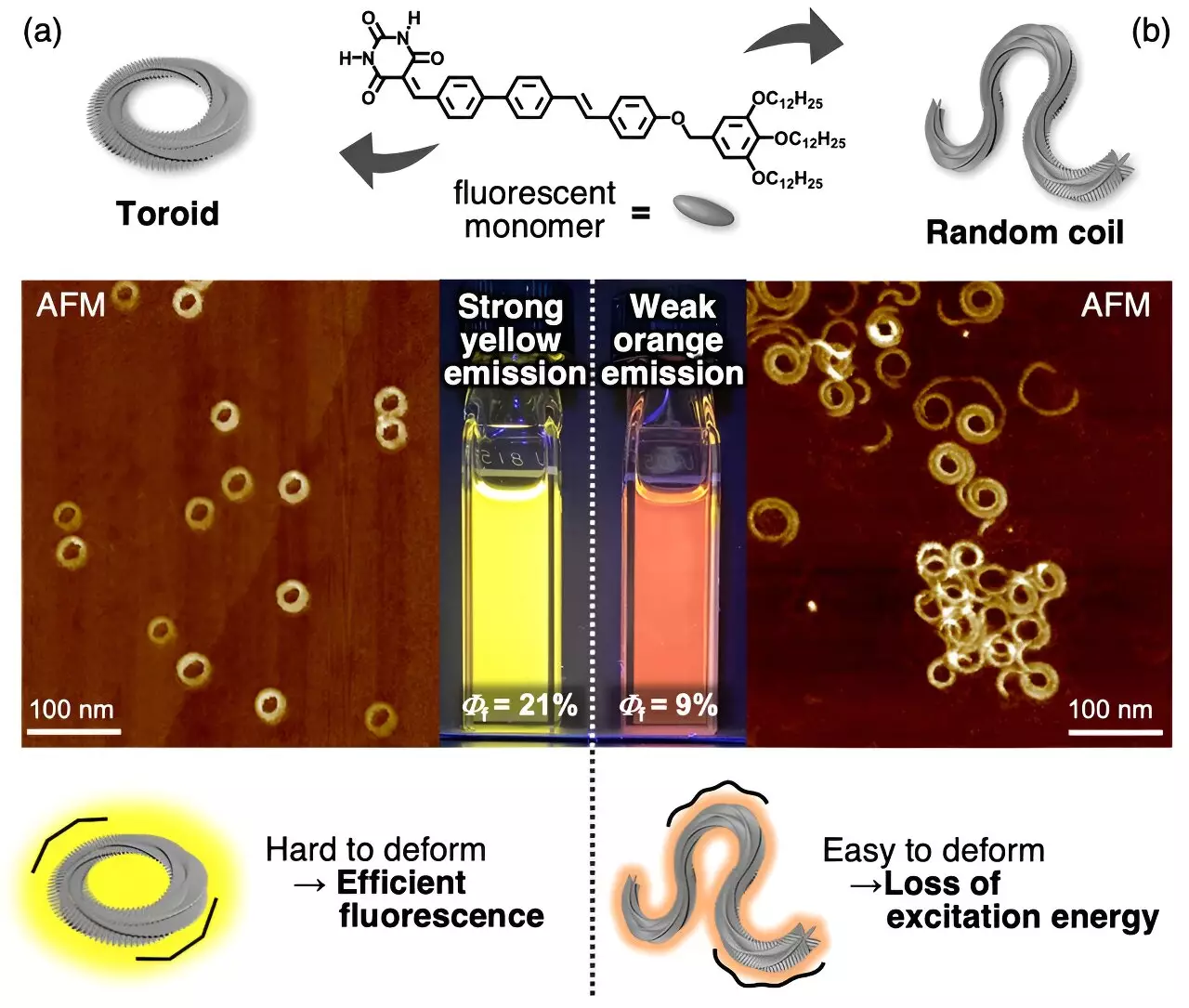Supramolecular chemistry involves the study of how the self-assembly state of molecules affects their properties. Scientists have long been fascinated by the idea of controlling and manipulating the self-assembled state in order to design materials with desirable properties. A recent study published in the Journal of the American Chemical Society delves into the properties of one-dimensional mesoscale supramolecular assemblies composed of the same luminescent molecule. The study reveals the impact of different molecular arrangements on the properties of these structures and highlights the importance of purifying the assemblies for accurate analysis of their photophysical properties.
The study, led by Prof. Shiki Yagai from Chiba University, focuses on investigating the properties of supramolecular polymer assemblies derived from the same monomer. One-dimensional mesoscale supramolecular assemblies with two different structures were examined: closed circular patterns and randomly coiled structures. The researchers aimed to understand how the arrangement of molecules within these structures affects their properties.
Circular structures have long fascinated scientists due to their geometrical beauty. The synthesis of giant cyclic molecules has been a subject of interest for chemists, not only for their aesthetically pleasing structures but also for the elegance of the synthesis process itself. One of the most remarkable natural examples of circular structures is the light-harvesting antenna organ (LH2, LH1) of purple photosynthetic bacteria. LH2 has a beautiful circular structure that allows for lean light collection and excitation energy transfer. Prof. Yagai and his team sought to explore the functional implications of circular structures in synthetic supramolecular assemblies.
Through the self-assembly of luminescent molecules, the researchers obtained a mixture of one-dimensional π-conjugated molecular aggregates with different structures: terminus-free cyclic structures (toroids) and randomly coiled structures. The mixture exhibited low-energy and low-intensity luminescence. To study the two structures separately, a novel dialysis technique was employed to exploit the difference in their kinetic stability. The researchers discovered that the terminus-free closed toroidal structure led to higher energy and more efficient luminescence compared to random coils.
Read More: The Impact of Juvenile Idiopathic Arthritis on Young People
Unveiling the Mechanism of Fluorescence Properties
To understand the mechanism behind the topology-dependent fluorescence properties, the team performed ultrafast laser spectroscopy. The results revealed that random coils with termini experienced excitation energy loss due to defects generated by fluctuations in solution. In contrast, toroids were more resistant to deformation and exhibited fluorescence without energy loss. Moreover, it was observed that when toroids and random coils were present in a mixed solution, the excitation energy transferred from toroids to random coils due to agglomeration, resulting in only random coil-derived luminescence being observed.
The study emphasizes the significance of purifying supramolecular assemblies before analyzing their photophysical properties, particularly in systems prone to supramolecular polymorphism like toroids and random coils. Failure to separate these structures may lead to biased results that do not accurately reflect their distinct properties, as energy transfer between different structures could occur. Therefore, purifying the assemblies is crucial to obtain reliable data and gain a deeper understanding of their properties.
The findings of this study pave the way for morphological control of materials at the mesoscale, offering new insights for the design of functional materials. The correlation between structural beauty and functional beauty discovered in this research opens up possibilities for improving the performance of solar cell devices and light-emitting devices. The ability to control the self-assembly state and manipulate the properties of supramolecular polymer assemblies holds great potential for the development of high-performance flexible devices using cyclic molecular assemblies.
The study led by Prof. Shiki Yagai sheds light on the relationship between molecular organization and the properties of supramolecular polymer assemblies. The research highlights the impact of structural arrangements on the luminescence of these assemblies, with closed toroidal structures exhibiting higher energy and efficiency compared to randomly coiled structures. The study also emphasizes the importance of purifying supramolecular assemblies for accurate analysis of their photophysical properties. Insights gained from this research open up possibilities for improved performance in solar cell devices and light-emitting devices, contributing to advancements in materials science and enriching people’s lives in the process.


Leave a Reply